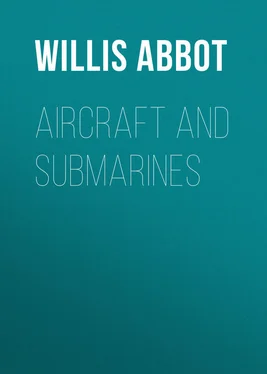Willis Abbot - Aircraft and Submarines
Здесь есть возможность читать онлайн «Willis Abbot - Aircraft and Submarines» — ознакомительный отрывок электронной книги совершенно бесплатно, а после прочтения отрывка купить полную версию. В некоторых случаях можно слушать аудио, скачать через торрент в формате fb2 и присутствует краткое содержание. Жанр: foreign_antique, foreign_prose, на английском языке. Описание произведения, (предисловие) а так же отзывы посетителей доступны на портале библиотеки ЛибКат.
- Название:Aircraft and Submarines
- Автор:
- Жанр:
- Год:неизвестен
- ISBN:нет данных
- Рейтинг книги:4 / 5. Голосов: 1
-
Избранное:Добавить в избранное
- Отзывы:
-
Ваша оценка:
- 80
- 1
- 2
- 3
- 4
- 5
Aircraft and Submarines: краткое содержание, описание и аннотация
Предлагаем к чтению аннотацию, описание, краткое содержание или предисловие (зависит от того, что написал сам автор книги «Aircraft and Submarines»). Если вы не нашли необходимую информацию о книге — напишите в комментариях, мы постараемся отыскать её.
Aircraft and Submarines — читать онлайн ознакомительный отрывок
Ниже представлен текст книги, разбитый по страницам. Система сохранения места последней прочитанной страницы, позволяет с удобством читать онлайн бесплатно книгу «Aircraft and Submarines», без необходимости каждый раз заново искать на чём Вы остановились. Поставьте закладку, и сможете в любой момент перейти на страницу, на которой закончили чтение.
Интервал:
Закладка:
Whether he observed the vicissitudes of his rival or not, Count Zeppelin determined that the advantages of a rigid frame counted for more than the disadvantage of its weight. Moreover that disadvantage could be compensated for by increasing the size, and therefore the lifting power of the balloon. In determining upon a rigid frame the Count was not a pioneer even in his own country. While his experiments were still under way, a rival, David Schwartz, who had begun, without completing, an airship in St. Petersburg, secured in some way aid from the German Government, which was at the moment coldly repulsing Zeppelin. He planned and built an aluminum airship but died before its completion. His widow continued the work amidst constant opposition from the builders. The end was one of the many tragedies of invention. Nobody but the widow ever believed the ship would rise from its moorings. It was in charge of a man who had never made an ascent. To his amazement and to the amazement of the spectators the engine was hardly started when the ship mounted and made headway against a stiff breeze. On the ground the spectators shouted in wonder; the widow, overwhelmed by this reward for her faith in her husband's genius, burst into tears of joy. But the amateur pilot was no match for the situation. Affrighted to find himself in mid-air, too dazed to know what to do, he pulled the wrong levers and the machine crashed to earth. The pilot escaped, but the airship which had taken four years to build was irretrievably wrecked. The widow's hopes were blasted, and the way was left free for the Count von Zeppelin.
Freed, though unwillingly, from the routine duties of his military rank, Zeppelin thereafter devoted himself wholly to his airships. He was fifty-three years old, adding one more to the long list of men who found their real life's work after middle age. With him was associated his brother Eberhard, the two forming a partnership in aeronautical work as inseparable as that of Wilbur and Orville Wright. Like Wilbur Wright, Eberhard von Zeppelin did not live to witness the fullest fruition of the work, though he did see the soundness of its principles thoroughly established and in practical application. There is a picturesque story that when Eberhard lay on his death-bed his brother, instead of watching by his side, took the then completed airship from its hangar, and drove it over and around the house that the last sounds to reach the ears of his faithful ally might be the roar of the propellers in the air – the grand pæan of victory.
Though Count von Zeppelin had begun his experiments in 1873 it was not until 1890 that he actually began the construction of his first airship. The intervening years had been spent in constructing and testing models, in abstruse calculations of the resistance of the air, the lifting power of hydrogen, the comparative rigidity and weight of different woods and various metals, the power and weight of the different makes of motors. In these studies he spent both his time and his money lavishly, with the result that when he had built a model on the lines of which he was willing to risk the construction of an airship of operative size, his private fortune was gone. It is the common lot of inventors. For a time the Count suffered all the mortification and ignominy which the beggar, even in a most worthy cause, must always experience. Hat in hand he approached every possible patron with his story of certain success if only supplied with funds with which to complete his ship. A stock company with a capital of $225,000 of which he contributed one half, soon found its resources exhausted and retired from the speculation. Appeals to the Emperor met with only cold indifference. An American millionaire newspaper owner, resident in Europe, sent contemptuous word by his secretary that he "had no time to bother with crazy inventors." That was indeed the attitude of the business classes at the moment when the inventors of dirigibles were on the very point of conquering the obstacles in the way of making the navigation of air a practical art. A governmental commission at Berlin rejected with contempt the plans which Zeppelin presented in his appeal for support. Members of that commission were forced to an about-face later and became some of the inventor's sturdiest champions. But in his darkest hour the government failed him, and the one friendly hand stretched out in aid was that of the German Engineers' Society which, somewhat doubtfully, advanced some funds to keep the work in operation.
With this the construction of the first Zeppelin craft was begun. Though there had been built up to the opening of the war twenty-five "Zeps" – nobody knows how many since – the fundamental type was not materially altered in the later ones, and a description of the first will stand for all. In connection with this description may be noted the criticisms of experts some of which proved only too well founded.
The first Zeppelin was polygonal, 450 feet long, 78 broad, and 66 feet high. This colossal bulk, equivalent to that of a 7500-ton ship necessary to supply lifting power for the metallic frame, naturally made her unwieldy to handle, unsafe to leave at rest, outside of a sheltering shed, and a particularly attractive target for artillery in time of war. Actual action indeed proved that to be safe from the shells of anti-aircraft guns, the Zeppelins were forced to fly so high that their own bombs could not be dropped with any degree of accuracy upon a desired target.
The balloon's frame is made of aluminum, the lightest of metals, but not the least costly. A curious disadvantage of this construction was made apparent in the accident which destroyed Zeppelin IV. That was the first of the airships to be equipped with a full wireless outfit which was used freely on its flight. It appeared that the aluminum frame absorbed much of the electricity generated for the purpose of the wireless. The effect of this was two-fold. It limited the radius of operation of the wireless to 150 miles or less, and it made the metal frame a perilous storehouse of electricity. When Zeppelin IV. met with a disaster by a storm which dragged it from its moorings, the stored electricity in her frame was suddenly released by contact with the trees and set fire to the envelope, utterly destroying the ship.
The balloon frame was divided into seventeen compartments, each of which held a ballonet filled with hydrogen gas. The purpose of this was similar to the practice of dividing a ship's hulls into compartments. If one or more of the ballonets, for any reason, were injured the remainder would keep the ship afloat. The space between the ballonets and the outer skin was pumped full of air to keep the latter taut and rigid. Moreover it helped to prevent the radiation of heat to the gas bags from the outer envelope whose huge expanse, presented to the sun, absorbed an immense amount of heat rays.
Two cars were suspended from the frame of the Zeppelin, forward and aft, and a corridor connected them. A sliding weight was employed to raise or depress the bow. In each car of the first Zeppelin was a sixteen-horse-power gasoline motor, each working two screws, with four foot blades, revolving one thousand times a minute. The engines were reversible, thus making it possible to work the propellers against each other and aid materially in steering the ship. Rudders at bow and stern completed the navigating equipment.
In the first Zeppelins, the corridor connecting the two cars was wholly outside the frame and envelope of the car. Later the perilous experiment was tried of putting it within the envelope. This resulted in one of the most shocking of the many Zeppelin disasters. In the case of the ship L-II. , built in 1912, the corridor became filled with gas that had oozed out of the ballonets. At one end or the other of the corridor this gas, then mixed with air, came in contact with fire, – perhaps the exhaust of the engines, – a violent explosion followed while the ship was some nine hundred feet aloft, and the mass of twisted and broken metal, with the flaming envelope, fell to the ground carrying twenty-eight men, including members of the Admiralty Board, to a horrible death.
Читать дальшеИнтервал:
Закладка:
Похожие книги на «Aircraft and Submarines»
Представляем Вашему вниманию похожие книги на «Aircraft and Submarines» списком для выбора. Мы отобрали схожую по названию и смыслу литературу в надежде предоставить читателям больше вариантов отыскать новые, интересные, ещё непрочитанные произведения.
Обсуждение, отзывы о книге «Aircraft and Submarines» и просто собственные мнения читателей. Оставьте ваши комментарии, напишите, что Вы думаете о произведении, его смысле или главных героях. Укажите что конкретно понравилось, а что нет, и почему Вы так считаете.












